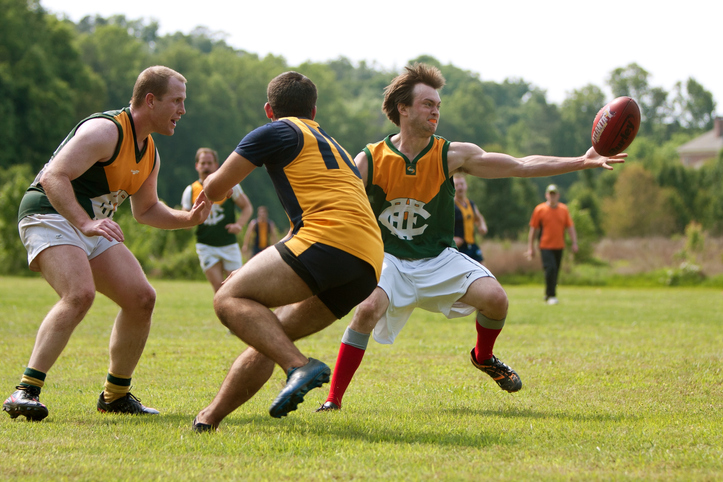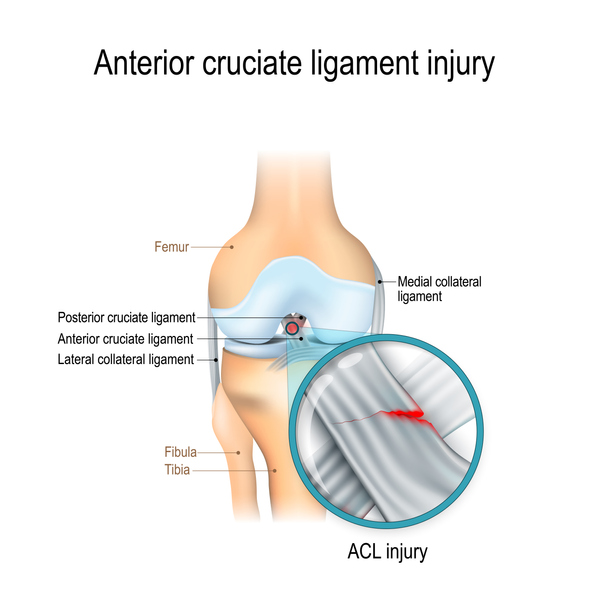Jump To
- Introduction
- Common AFL injuries
- AFL injury prevention tips
- Treatment
- References
Introduction
Australian Rules Football – commonly referred to as Aussie Rules or AFL (after the Australian Football League) – is one of Australia’s most popular sports. More than 1.5 million people, both male and female, participate in community club Aussie Rules all over the country.1 The nature of Aussie Rules – a high-level, fast-flowing, contact sport – predisposes players to injuries both unique to the game as well as common to many contact sports.2 Often injuries arise from tackling, kicking, high-speed running, jumping, colliding and constant physical competition for the ball.2,3
Common AFL injuries
A total of 680 injuries were reported by the 18 clubs that played in the 2017 AFL season, representing a slight decline from previous years. The most common AFL injuries and their causes include:5
The hamstrings are a group of muscles at the back of the thigh. Hamstring strains are perennially one of the major reasons players miss games through injury. Hamstring strains usually occur at the end of the ‘swing phase’ in running – when the leg swings forward and the knee straightens. During this stage, the hamstrings try to stop the forward movement of the leg and bring the foot down.6
Certain factors that increase the risk of straining the hamstrings include: reduced flexibility, poor fitness, poor endurance, an imbalance in strength and flexibility between the leg muscles, and back involvement which can irritate the nerves that go to the hamstrings.6
Image Credit: Source
Get on top of your physical health
Find and instantly book affordable physios within Australia
2. Ankle sprain
Ankle sprains are the most common type of ankle injury in AFL.5 They occur when the ligaments of the ankle are over-stretched or torn.8 This commonly happens when landing on your foot awkwardly after a jump or turn, or when some-one else lands on your foot during a game.9 Click here to read more about ankle sprains.
3. Calf strain
Calf strains typically occur when players accelerate quickly from a stationary position or stop suddenly after sprinting. In most cases, the injury is caused through sudden ‘eccentric’ stretching of the gastrocnemius (calf) muscle, which is when the calf muscle is contracted, but suddenly and forcibly lengthened.10
Image Credit: Source URL
Concussion is a brain injury that results from impact to a player’s head. Generally, this happens following a collision with another player or with the ground. During a high impact collision, the brain can move back and forth within the skull causing temporary side effects.
However, the effects of concussion aren’t always immediate; sometimes the signs and symptoms reveal themselves hours after the injury.12
5. Groin strain and osteitis pubis
Groin strains are injuries that occur to one of the muscles or tendons located within the groin region. The groin muscles are commonly used in sprinting, side-to-side lunging or stepping, and kicking.13
Osteitis Pubis (OP) is a common cause of ongoing groin pain in AFL. It is considered an overuse injury rather than an injury that results from a specific incident. The main cause of OP is instability of the pelvic bones, particularly the pubic symphysis. This instability is worsened during actions that place asymmetrical loads on the pelvis, such as running or kicking.14
Anterior cruciate ligament (ACL) injuries receive arguably the most attention out of all types of knee injuries in AFL. The knee is a complex hinge joint that primarily performs two actions – bending and straightening of the lower leg. The ACL prevents the femur (the thigh bone) from moving forwards during weight bearing, as well as helping to prevent over-rotation of the joint. ACL injury most commonly occurs when a player is pivoting, suddenly slowing
down, or landing from a jump.15
7. Shoulder sprain and dislocation
A shoulder sprain occurs when the shoulder ligaments – the fibrous bands that support the shoulder – are over-stretched and torn. The most common shoulder ligament affected occurs at the joint between the acromion and the clavicle (the collar bone). This type of injury is usually caused by a strong, direct blow to the front or top part of the shoulder (such as from a heavy collision or crashing to the ground).17
Shoulder dislocations occur when the humerus (the upper arm bone) ‘pops out’ of the cup-shaped socket of the shoulder blade. It generally requires a strong force to pull the bones out of place, such as a sudden forceful blow to the shoulder or extreme rotation of the shoulder. 18 90% of shoulder dislocations are anterior dislocations, meaning that the upper arm bone has been displaced forwards of the socket.19
While each of the aforementioned injuries have specific causes, there are some general safety tips that can help to reduce the overall risk of injury for both Aussie Rules and contact sports in general:3
1. Be well prepared and match-ready.
- Make sure you are match-ready by doing the appropriate amount of training beforehand, including practising the required game-specific skills and techniques
- Ensure that you use pre-season training to improve and consolidate strength, flexibility, balance, agility and stamina
2. Make sure the environment is safe
- Make sure the field is safe by removing or covering any potentially dangerous hazards, such as glass or sprinklers
- Cover all cricket pitches on the footy field with a soft surface
- If there are fences, make sure they are a distance of at least three metres from the boundary
- Make sure that all goal posts are padded
- Make sure that first aid kits, ice packs and stretchers are available at all times, as well as personnel with official first aid training
- Ensure telephone access to emergency services
3. Safety tips before the match
- Complete appropriate warm up activities
- Drink water before matches and training
- Have a well-balanced diet
- Wear appropriate footwear
- Apply sunscreen
- Be aware of the rules and agree to play fairly
4. Safety tips during the match
- Wear a mouthguard at all times
- Players with a history of head, ankle or thigh injuries should be encouraged to wear helmets, ankle braces or thigh protectors
- Remain hydrated during and after the match
- Umpires should ensure that the rules are followed at all times
- Avoid drinking alcohol after the match
If you would like more injury-specific prevention advice, or if you have previously suffered a sports injury, it is recommended that you visit your local physiotherapist.
If an injury occurs during an Aussie Rules match, prompt medical advice should be provided by coaching staff who are officially trained in first aid. Importantly, a health professional should have the final say as to whether or not it is safe for a player to return to the field.3
Concussion warrants special mention – any player with concussion symptoms must be seen by a health professional. AFL’s official policy is that anyone with concussion must not immediately return to play.9
It is important to ensure that players undertake appropriate rehabilitation, including physiotherapy, before returning to play.3 Visiting a local sports injury clinic or physiotherapist can help injured players create individualised recovery programs, which is particularly important for serious or recurring sports injuries.
A: Use HealthEngine to find and book your next Physiotherapist appointment. Click on the following locations to find a Physiotherapy clinic in your state or territory.
This article is for informational purposes only and should not be taken as medical advice. If in doubt, HealthEngine recommends consulting with a registered health practitioner.
1. Australian Football League (online). AFL Annual Report 2017 [accessed 26 Feb 2019].
2. Saw, Richard, et al. "Injuries in Australian rules football: an overview of injury rates, patterns, and mechanisms across all levels of lay." Sports health 10.3 (2018): 208-216. Available from: URL link
3. Sports Medicine Australia (online). Facts on Australian football injuries [accessed 26 Feb 2019]. Available from: URL link
4. Wikimedia Commons (online). Image: Shiels injury [accessed 27 Feb 2019]. Available from: URL link
5. Australian Football League (online). 2017 AFL Injury Survey [accessed 26 Feb 2019]. Available from: URL link
6. Australian Football League (online). AFL Community: Hamstring Strains [accessed 26 Feb 2019]. Available from: URL link
7. Wikimedia Commons (online). Image: Pulled Hamstring [accessed 27 Feb 2019]. Available from: URL link
8. Queensland Government (online). Emergency Department fact sheets: Ankle sprain [accessed 18 Feb 2019]. Available from: URL link
9. Mayo Clinic (online). Sprained ankle [accessed 18 Feb 2019]. Available from: URL link
10. Sports Medicine Australia (online). Gastrocnemius (Calf) Strain [accessed 26 Feb 2019]. Available from: URL link
11. Wikimedia Commons (online). Image: Sobo [accessed 27 Feb 2019]. Available from: URL link
12. Australian Football League (online). AFL Education: Concussion [accessed 26 Feb 2019]. Available from: URL link
13. Virtual Medical Centre (online). Groin strain [accessed 26 Feb 2019]. Available from: URL link
14. Physio Works (online). Osteitis Pubis [accessed 26 Feb 2019]. Available from: URL link
15. Sports Medicine Australia (online). Anterior Cruciate Ligament Injury [accessed 26 Feb 2019]. Available from: URL link
16. Wikimedia Commons (online). Image: ACL tear [accessed 27 Feb 2019]. Available from: URL link
17. Harvard Medical School (online). Shoulder Sprain [accessed 26 Feb 2019]. Available from: URL link
18. Mayo Clinic (online). Dislocated shoulder [accessed 26 Feb 2019]. Available from: URL link
19. Australian Football League (online). AFL Community: Common Upper Limb Sports Injuries [accessed 26 Feb 2019]. Available from: URL link
20. Wikimedia Commons (online). Image: Shoulder dislocation, anteroposterior before reduction [accessed 27 Feb 2019]. Available from: URL link
All content and media on the HealthEngine Blog is created and published online for informational purposes only. It is not intended to be a substitute for professional medical advice and should not be relied on as health or personal advice. Always seek the guidance of your doctor or other qualified health professional with any questions you may have regarding your health or a medical condition. Never disregard the advice of a medical professional, or delay in seeking it because of something you have read on this Website. If you think you may have a medical emergency, call your doctor, go to the nearest hospital emergency department, or call the emergency services immediately.











